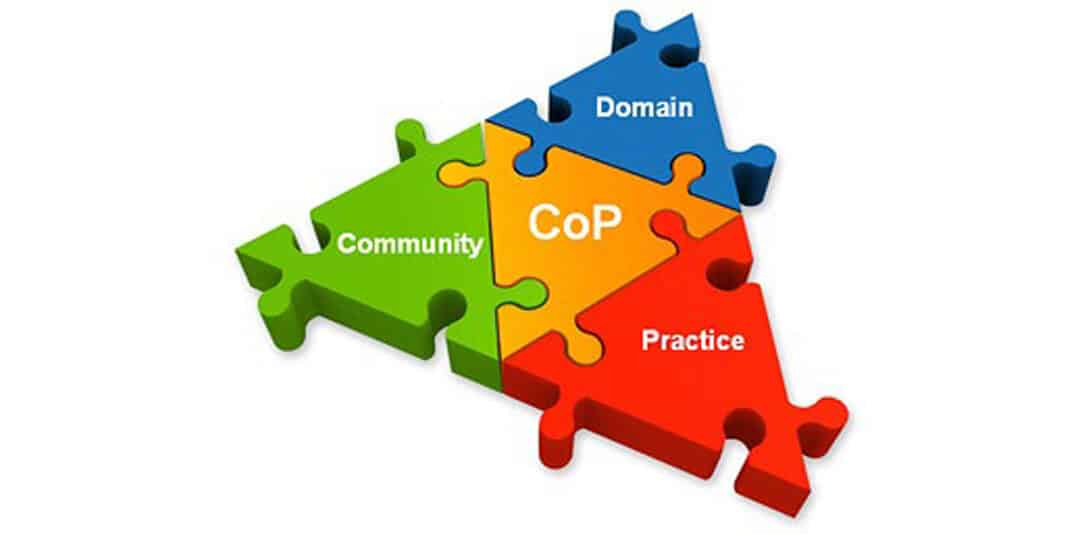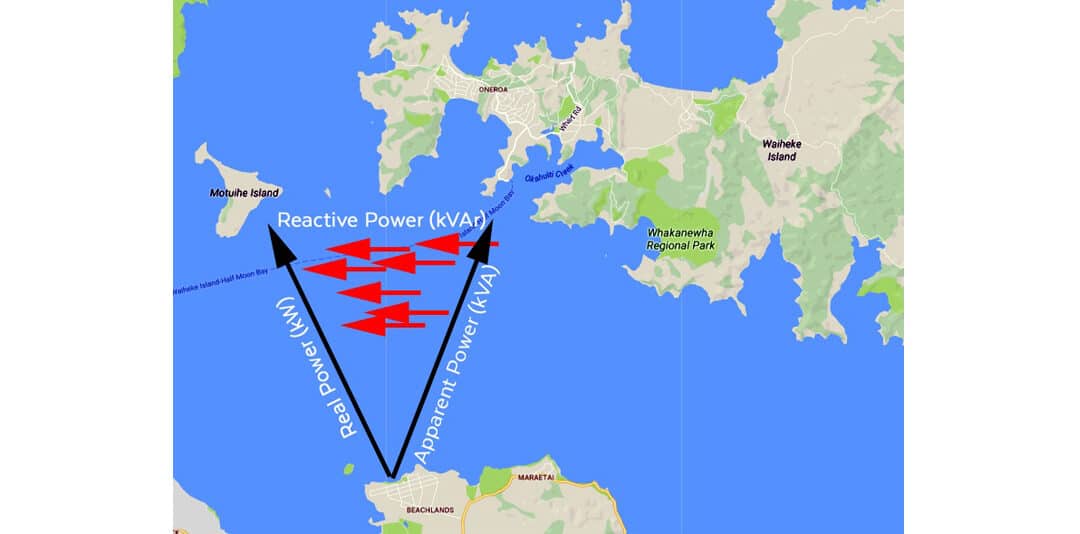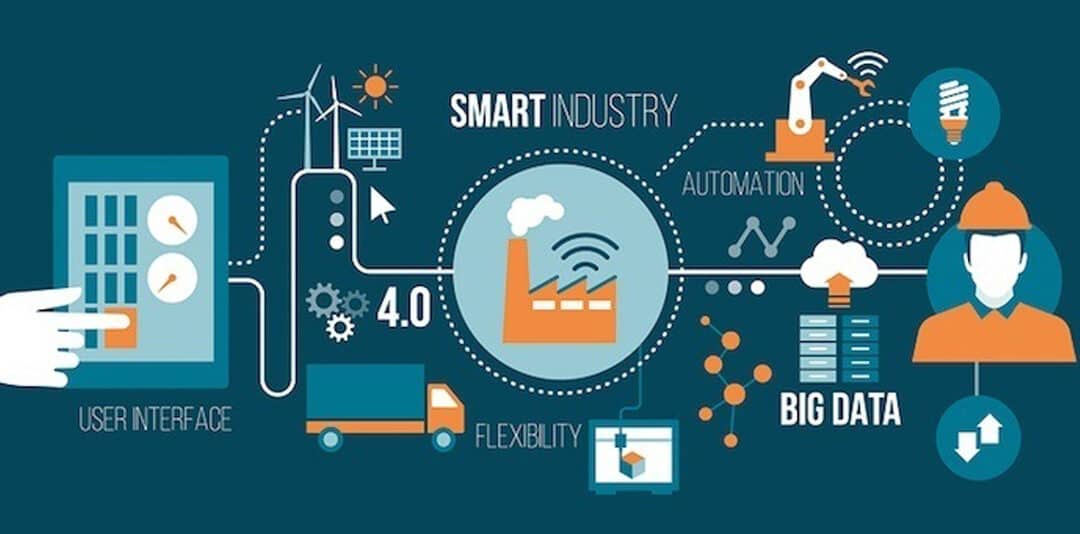
by DavidSpratt | Nov 3, 2017 | ICT
This is the third and final article on Communities of Practice (COPs), a model designed to help align business strategy with the evolving knowledge and experience of your people, while still taking advantage of the efficiencies that can be gained through more formal organisational structures and processes.
I can now safely say, after many years of practice — complete with a few painful cock-ups along the way — that the workplace model, Communities of Practice (COPs), does work. Making Communities of Practice work doesn’t happen on its own, but with the right groundwork in place and organizational support they can flourish.
COPs are made up of three essential elements: a domain (common ground or project), community (the particular group of people working on the domain), and practice (the community’s actions taken to develop and share knowledge in carrying out the job together).
There are six key components to making Communities of Practice work in the real world
1. Select the Practices that will underpin business strategy and unite your people
This process isn’t dictated by one manager. We pulled together a team of respected leaders and experts in the business and charged them with finding an initial group of three areas for “practice development”. That team determined that the business’ management of records and documents, information security, and messaging, were critical technologies with skills, activities and innovation at a premium.
Getting people to agree on exactly what “messaging” meant, for example, was difficult.
Expect the first few COP sessions to be talk fests where people debate in minute detail exactly how the particular Practice is defined, what members should be doing , how they will do it and what outputs they expect.
2. Identify the right people to participate
We asked for volunteers. Trying to name people and then advise them “congratulations we have found another way to suck the joy out of you” just doesn’t fly. We recognise many dedicated staff already work longer hours than is good for them.
3. Make time and resources available
Asking your busiest expert to take on a COP lead role without providing support and resources will see him or her head out the door faster than you can say “Mummy has moved in with Uncle Bob”.
Over time the Practice will introduce efficiencies and improvements that make work more enjoyable and effective, but it won’t happen overnight and you need to plan for that in terms of resources and people’s time.
4. Find easy-to-use technology to ensure ongoing engagement
When we first started COPs we thought a couple of face-to-face meetings a year and a monthly video or voice conference would be enough to drive results. How wrong we were! After a short time, the demands of day-to-day work took over, excitement waned and we struggled to keep people engaged.
The arrival of instant messaging tools such as SharePoint, Skype, Google docs, hangouts, classrooms and chat forums have changed everything. Communities of Practice can now be made a practical reality for an extremely low cost and with astonishing speed and availability.
5. Set realistic goals and objectives for each Practice
At first, we tried to set grand goals for Practices. As expected, everyone became confused, frustrated and rapidly lost interest. So, we changed tack and asked, “What is the biggest single problem we face and how could we solve it?” By narrowing down the discussion to a short, sharp challenge, people became more engaged.
As important as engagement is to making Communities of Practice work, it was an unexpected consequence. It turned out that many people had actually solved this specific problem in the past, either in their region or at another job. Often, they had spent hours at home building a powerful and viable answer to the problem. It was just that no one knew about it!
The Practice provided these people with a forum for sharing their solutions with colleagues who were genuinely interested and could offer further improvements.
6. Appoint executive sponsors who are accountable for results
In saying this, I don’t mean some poor middle manager who has just been assigned to COPs “special projects” while you prepare to clean out his office. Accountability for COPs is an executive role for two reasons: they will make sure it succeeds; and the people involved will actually believe it will succeed.
Confidence is essential when starting any new initiative, and Communities of Practice are no exception.
This is part three of a series. If you missed it, catch up on parts one and two here: Forming Communities of Practice and three essential elements for successful Communities of Practice.

by DavidSpratt | Oct 31, 2017 | Case Studies, ICT
 In 2013, Zespri, one of the world’s leading horticultural companies, and the recognised category leader in kiwifruit, was facing many significant challenges. The Psa virus which attacked their main gold kiwifruit crop, had the potential to devastate the company and its grower shareholders. In addition, they were facing significant capital outlays associated with their existing ICT systems and the need to upgrade their computer hardware.
In 2013, Zespri, one of the world’s leading horticultural companies, and the recognised category leader in kiwifruit, was facing many significant challenges. The Psa virus which attacked their main gold kiwifruit crop, had the potential to devastate the company and its grower shareholders. In addition, they were facing significant capital outlays associated with their existing ICT systems and the need to upgrade their computer hardware.
Zespri had to ask questions like, “Could the new variety of crop, Sun Gold, be more robust and become another bestseller?”, or, “Would our outputs dramatically reduce?” At the same time, Zespri’s Board were concerned about identifying and mitigating the risks of a natural disaster like the tsunami in Japan or the earthquakes in Christchurch. Their data centres were located in Mount Maunganui and backup services in Tauranga. They wanted to understand the impact these types of events could have on their onsite server and storage infrastructure.
Measured Baseline Informs Strategy
Undertaking the initial analysis of Zespri’s current position, we established a baseline ICT cost. This baseline was used as a benchmark to inform financial decision-making and monitor ongoing expenditure.
With assistance from the team at Total Utilities, Zespri evaluated its ICT data centres and infrastructure services and platforms. The objective was to determine whether they could manage the range of potential outcomes that they faced. These systems would have to be flexible enough to adapt to both the best case and the worst-case scenarios.
Zespri sought Total Utilities’ independent advice to identify and assess out how they could best respond to these risks and opportunities. They ultimately saw the need to inform vital decisions around how they consumed computer services with a scalable and cost-effective model that was aligned with their overall financial and business strategy.
Undertaking the initial analysis of Zespri’s current position, we established a baseline ICT cost. This baseline was used as a benchmark to inform financial decision-making and monitor ongoing expenditure. Using this measure, we demonstrated to the CIO and CFO and subsequently their executive and board, significant savings could be made by moving to a monthly subscription model based on public cloud services.
In the future increases above the baseline, increased spending in ICT, would be indicative of Zespri’s growth. The baseline is a very useful comparative tool, both for supporting financial decisions and controlling monthly spend.
After conducting a thorough analysis of the needs and opportunities available to Zespri, we provided the quantitative data that underpinned the business case presented to their board. Total Utilities subsequently supported Zespri through our independent Request for Proposal process to choose a candidate for the migration to, supply and support of a comprehensive cloud-based infrastructure running over the Microsoft Azure Platform.
Moving ICT operations to Microsoft’s Azure cloud computing platform has many advantages including access to data from anywhere and at any time, an IT environment that is quick and easy to replicate as new offices open and new services become available, and it can effectively respond to the increased competitiveness that occurs when other global players enter the market.
In addition, moving to Azure mitigated the risk of natural disasters crippling the closely located physical data centres.
Ongoing Insights and Cloud Analytics
Our commitment to providing Zespri with a dynamic and meaningful experience meant that our relationship continued past the selection phase. With our expertise in financial analytics we continue to provide them with forever evolving insights. Steve Wichman, Zespri’s Procurement and Commercial Manager, outlines how Zespri is moving into an ICT maturity phase. With this the board is always looking for ways to optimise their systems. The regular technical and financial input from Total Utilities is very useful in this regard, Steve describes us as a sounding board and an independent voice.
Zespri utilise the Total Utilities cloud management service based on our analytics, reporting capability and the Cloudyn tool. Providing these reports and monthly insights we can help ensure that expenditure is aligned, appropriate, and adaptable to Zespri’s financial strategy. We also help them manage and mitigate the risks associated with an OPEX approach, bill shock, by providing them with real-time alerts of consumption. Steve states that these reports provide insights on how Zespri can best optimise their systems, analyse exceptions, and determine how they can improve their current and future operating state while reducing overall expenditure.
Customer-Centric and Flexible Reporting
The board is always looking for ways to optimise their systems. The regular technical and financial input from Total Utilities is very useful in this regard.
The dynamic nature of our service to Zespri means that, as well as providing clear and understandable reports, our analytics extend to creating what-if scenarios. For example, we can analyse what might happen if Zespri consolidated or expanded some of its ICT services. This approach means we can project future cost savings or increases accurately.
Total Utilities insights, financial analysis and recommendations have become more meaningful as more data is gathered and more avenues explored. We can now calculate ICT costs on a “per service” basis. This allows Zespri to identify the true cost of financial, operations, marketing or any other system that requires ICT resources. Our benchmarking and cash projection approach extends to three-yearly reviews of the business case. These reviews are vital to ensure that the case remains relevant to Zespri’s situation and consistent with the parameters set by the board. Regular reviews, along with ongoing monthly, quarterly and annual reporting, are at the heart of Zespri’s ongoing drive to extract the maximum, identified and projected value available from the Microsoft Azure platform of services.
Understanding Key Business Drivers to Leverage Competitiveness
Other ICT consulting companies might focus on the technology or hardware, we take a financial analytics approach that sees ICT as a consumable and adjustable utility. This means consumption and costs are transparent, flexible and optimised. We believe ICT should be financially appropriate for a company, aligned with their goals, and be able to adapt to real-world factors. We do all this by establishing a baseline of costs, creating a detailed business value analysis in support of a business case and then deliver regular monitoring. This approach informs understanding of the company’s consumption, costs and benefit realisation from their Azure based ICT systems. This is the multi-faceted and valuable service that we continue to provide to Zespri.
Finally, would Steve at Zespri recommend us to other companies? A resounding yes. Our strong and dependable relationship, the way we deliver on a job both in quality and in timeliness, and our independent and trusted advice, is hard to find elsewhere.

by DavidSpratt | Oct 26, 2017 | ICT
Last month I introduced Communities of Practice, a model designed to help align business strategy with the evolving knowledge and experience of its people, while still taking advantage of the efficiencies that can be gained through more formal organisations and processes.
There are three elements that make up a Community of Practice. These are Domain, Community and Practice.
Domain
The common ground that inspires members to join, drives their learning activities and gives purpose and meaning to their activities.
Let’s take a simple example. Yours is a plumbing and gas fitting firm with offices across the country. The building boom has meant that Christchurch, Nelson, Auckland and Tauranga are seeing increased demand for the design and installation of sophisticated gas heating systems and appliances in new, architecturally-designed homes, shopping centres and offices.
In each of these main centres you have a mixture of apprentices, newly-qualified and experienced tradespeople working under a standard organisational structure with supervisors and a branch manager.
The domain in this instance is the design, selection and installation of new gas systems. The reason people join (purpose) is to share ideas and come up with best practice by taking advantage of the work that community members have done, whether in training at apprentice school, at their previous job or on the job last week.
The motivation (meaning) is twofold. To be recognised by your peers and to learn from the experience of others, in an environment where the company rewards these activities.
Community
Creates the social fabric for learning.
Our plumbers and gas fitters are in a mixture of locations and have a wide variety of experience and insights and formal learning. In reality though, they do not have a great deal in common other than their learning domains.
In our imaginary firm, Jim and Rod have a common cause when it comes to the knowledge they are sharing from Jim’s last project. Jim is sharing his ideas and experience from a job where he specified and installed the latest gas appliances from a new European supplier. Rod is about to install the same equipment on his next job and is worried about getting the specification wrong. He has never seen or installed the equipment before and the job has contracted delivery milestones and quality demands.
What I haven’t mentioned is that Jim only just qualified as a gasfitter last year. He finished his apprenticeship with another company in Dunedin and only just joined the Christchurch team in January. Rod, on the other hand, has worked for the Auckland branch as a supervisor for twenty years and is regarded as the top dog in the Auckland office.
Jim wears tight jeans and sports an indie-style beard, while Rod has a beer gut and listens to Led Zeppelin. In normal circumstances, these two vastly different people with seemingly nothing in common would never have come together for the betterment of themselves or their firm. The Community of Practice that the company has established means that knowledge and skills are now becoming a part of the fabric of how things are done at work regardless of location or status.
Practice
The Practice component of a Community of Practice is the point of action around which a community develops, shares and maintains its knowledge.
A Practice is built on establishing, recording and sharing formal methods (explicit knowledge) and practical experience (tacit knowledge). It delivers reusable and constantly evolving best practice while making room for innovation. It allows the firm to continue to constantly improve its standards regardless of changes to the organisational structure or the movement of staff.
Jim’s willingness to share his drawings and installation instructions and, importantly, to take the occasional phone call from Rod has created genuine, measurable customer value on his latest job. These drawings and connections also endure for all community members and the firm. This motivates staff, creates a sense of belonging and maintains competitive advantage for the company as a whole as it evolves in a tough, competitive market. This is the basis of Communities of Practice.
Part Three of this series covers the most important question of all. How do we break down the structural, cultural and political barriers that exist to Communities of Practice while maintaining the day-to-day organisational framework that ensures the business operates in the day to day?

by chris | Sep 26, 2017 | News, Power Factor
What is Power Factor and why is it Important?
Power Factor is an electrical term that is the measurement of how efficient energy consuming equipment translate that energy into a useful output. It is measured by the ratio (>0 and <1) between apparent power (kVA) and real power (kW), where apparent power is the amount of energy required to deliver a required output. Power Factor should be as close to 1 as possible (above 0.95) so that apparent power and real power are nearly the same. This means that nearly all the energy consumed is translated into a useful output.
An analogy of this is a boat travelling in a straight line from Beachlands Marina to Waiheke, with no wind and water currents it can easily make the trip without difficulty (real power), however in the real world, environmental factors exist which, if not allowed for, will make the boat travel off course or get to its destination much slower. The boat requires more energy (apparent power) to counteract the wind and ocean currents to arrive safely at its destination in its desired timescale. With stronger wind and currents, more energy is required to make the same trip and perform the same action.
In an ideal world, the boat would only travel on calm sunny days as this would maximize the energy output in travelling to Waiheke Island.
This Overlooked Charge on Your Energy Bill Could be Costing You Dearly
Returning to buildings, manufacturing plants and industrial sites, power factor is caused by inductive energy loads, these are the wind and ocean currents that can potentially mean that we use more energy than is necessary to run our equipment. Inductive loads include:
- Transformers
- Induction motors
- Induction generators (wind mill generators)
- High intensity discharge (HID) lighting
Sites with poor power factor (a low ratio of below 0.95) create disturbance in the local electricity distribution network which can require the network operators to build more infrastructure than is required to deliver power to customers.
Power Factor Charges
We regularly come across customers who are not aware they are being billed for poor power factor, in most cases the energy retailers are not concerned about these charges as they are pass-through network costs. Most North Island and some South Island energy distribution networks charge customers with poor power factor. Pricing is mostly standardised through the country at around $8.90 per reactive kVA unit per month, however penalty times and the way the billable Power Factor is calculated varies between networks.
An example of this is below, covering a customer located in the Vector Network in Auckland.

This is an extreme case, however shows what customers should look out for on their energy bills. If poor power factor is charged, along with a peak kVA demand charge, then customers are paying a higher cost for peak demand as poor power factor inflates this. Like the analogy above, a greater amount of kVA energy is needed to get to Waiheke due to strong winds and ocean currents.
 What can be done to correct Power Factor?
What can be done to correct Power Factor?
Power Factor can be corrected through the installation of capacitor banks, traditionally these consisted of a control unit and a series of capacitors that would filter the power used on site as required. Modern units are evolving quickly as technology advances where sophisticated software can deliver granular correction with less capacitors to ensure that power factor remains above 0.95. Fully active systems delivering electronic real time correction are also becoming more accessible but remain very expensive and only suitable for specific situations. Hybrid systems are also available, but again, these are suited to specific situations.
There are numerous businesses out there offering power factor correction, many companies only offer off the shelf type products. The danger here is that they are not specifically designed to a customers requirements and can be either under sized (i.e. they wont correct all of the power factor issue) or their over sized (i.e. a customer will pay for more than what they need). Standard step sizing of the capacitor banks may be too large which means correction only works at large loading as the unit lacks the granularity to correct smaller loadings.
 What if I have a unit already installed?
What if I have a unit already installed?
Depending on the age and design, most units can be repaired or upgraded. However older units may need to be replaced as it would be a case of just throwing good money after bad.
Unfortunately Power Factor Correction Units are not a set and forget product, just like a car they need a regular annual inspection. Having your unit checked on an annual basis is a good way to make sure that they continue to run efficiently and you get 100% value out of an expensive asset. All too often we hear of customers say, “but I installed a unit 3 years ago, why am I still being charged for power factor?”
If the unit was designed correctly in the first instance and the customer has not outgrown it, the most likely issue is heat. Capacitors have a life cycle of around 10 years if kept cool. However if they are regularly exposed to temperatures above 30 degrees they can begin to fail. This is why unit design is important and relates to the location of where the unit is installed. Off the shelf products will not consider this.
Who do I call?
Total Utilities can assist customers in building the business case to install or repair correction equipment, illustrating potential savings and relative return on investment based on measured half hour interval data.
We can design and install Power Factor Correction Units through kAVrCorrect (Formerly Metelect in Rotorua) so that customers receive and full end to end service.

by DavidSpratt | Sep 13, 2017 | ICT
A colleague from one of New Zealand’s emerging winners in the software development market tells me that, despite its success, he is concerned about whether he is utilising the very expensive specialists in his business to best effect.
He bemoaned: “It seems the bigger we get, the more time wastage we create.
“Our best people are already frustrated at the inefficiencies and are headed to the door.
“It’s hard enough finding top people without losing the best of the best to our competitors. We pay well. We have a great environment in our offices and our customers are blue chip – what am I getting wrong?” he said.
Many companies face the same problem. The business grows and people begin to disconnect, both from each other and from the business’ strategic direction. As silos are created by management, knowledge sharing and common approaches to problem-solving are replaced by “standards and procedures”. The business becomes burdened under red tape while its creative excitement seems to be drained of energy with every additional memo.
As entrepreneurs, we all know this story and understand that as businesses grow it becomes necessary to institute a level of structure to address complexity. While bringing order and control the unintended consequence can often be a stifling of the creativity and a growing structural inability to share ideas.
People in all sorts of organisations share their experience, learn new skills and create innovations. In larger, more structured organisations these learnings can often end up remaining in the head of the individual or local team, simply because business rules, targets and individual measures make sharing ideas counterproductive to the individual.
Communities of Practice
Emerging across the business world now are “communities of practice” as a means of ensuring that the skills, experiences and ideas of our staff are constantly shared and refreshed to the benefit of the participants and, vitally, for the business
An early exponent of Communities of Practice, US-based educational theorist and practitioner Etienne Wenger, has spoken about the challenge of restructuring organisations to improve performance while avoiding the destruction of innovative capital. In essence, he believed, communities could exist within an organisation and people continue to share and create new ideas regardless of the department or team they worked in. Knowledge and strategy, it seemed, could coexist without adding further inefficiency.
So how do we establish and run these communities? With tools like mobile phones, Skype and intranets it isn’t all that difficult. All you need are willing people, a common purpose and a point of focus.
These are three main components to be considered in establishing communities of practice:
- Domain
The common ground that inspires members to join a community of practice drives their learning activities and gives purpose and meaning to their activities.
- Community
A community creates the social fabric for learning. It brings together experts and learners while encouraging meaningful interactions – a willingness to share what is in their heads, for common goals and shared growth.
- Practice
The community needs a point of action, or practice, around which it develops, shares and maintains its knowledge.
By implementing Communities of Practice in the work environment, you can make a difference in how key teams operate… That helps increase efficiency and stops that talent walking out the door.
Next month, I will examine domains and communities in more detail.

by DavidSpratt | Jul 24, 2017 | Energy
The boundaries between physical, digital and biological worlds are breaking down — giving way to a new world of computer based business known as cyber-physical systems. These cyber-physical systems are characterized by the merging of physical, digital, and biological realms in profound ways. Artificial intelligence (AI) serves as the primary catalyst of this transformation.
Klaus Schwab, Chairman and Founder of the World Economic Forum wrote:
We are at the beginning of a revolution that is fundamentally changing the way we live, work, and relate to one another. In its scale, scope and complexity … the fourth industrial revolution is unlike anything humankind has experienced before.

We have all heard this kind of hyperbole before. So why should this matter and what are local companies doing to address the issues?
Beyond hyperbole
It matters because we have already seen our lives changed by these tools in the most dramatic fashion. The last presidential election in the USA was directed affected by the use of AI.
These tools were used in identifying and directly addressing those electors who were undecided or felt strongly about key issues. These powerful compute engines, combined with good old-fashioned phone calls and door knocks, meant voters were either encouraged to vote by “people like them” who knocked on the door (e.g. young mum talking to young mum) or to not vote through messages directed directly to them about the futility of “rigged” elections.
Leveraging AI in the New Zealand Business Context
Politics and business are uneasy bedfellows so I will get back to the brief. How do Kiwi companies respond to international and local competitors who already understand and are leveraging artificial intelligence and bringing it to our competitive landscape?
Let’s start with energy. It is one of the most fundamental parts of any business. Most of us just focus on getting a cheap price for electricity or gas and then move on to running the enterprise day to day.
This approach just won’t work when machines are making the micro-decisions that can mean success and failure.
International Competition
Consider some of our major New Zealand computer companies. They are in a life or death struggle with public cloud providers like Microsoft, Amazon and Google. These gigantic multinationals have access to all the tools mentioned above and even deliver them “as a service” to companies everywhere. Competing with organisations like this is not just a question of having good people or getting the best price for inputs. It is about innovation and very, very careful monitoring of all the inputs and outputs, including energy.
One of the most brutally competitive battlegrounds is over the provision of data centre services to the business market. In the past ten years companies like Datacom and Spark have invested hundreds of millions of dollars in state of the art datacentres. These datacentres require huge amounts of energy to keep them running.
New Zealand’s advantage
New Zealand has a natural advantage because over 80% of our energy is created via renewable means. In the years ahead this advantage will become a cost and strategic advantage.
As the forth industrial revolution unfolds New Zealand’s energy advantage that will drive our strategic advantage in data centres. Don’t believe me? Microsoft recently announced that a key new measure for its Azure data centres was energy inputs to data outputs. Thus Microsoft has directly linked energy usage as a means to define its compute power efficiency in terms of services delivered.
So what are our Kiwi companies doing to compete on this stage? Both Datacom and Spark use tools like artificial intelligence to monitor, control and measure their energy inputs. Historically it was simply a case of installing a few sub meters and a cost calculator (macro energy measurements). Today these companies aim to measure and monitor right down to the lightbulb (micro monitoring). The rise of the internet of things has made this ability to micro monitor even greater. As new data centres and factories are being built across the country, architects are being required to include in their plans, tools and products that embed internet of things, artificial intelligence and micro monitoring in the very fabric of the design.
Companies building factories in this country that do not think of micro monitoring of energy use as a strategic tool should be reminded that in the last few decades we exported more manufacturing jobs overseas than we created in all of IT. Ignorance of the strategic possibilities of micro energy monitoring is wilful blindness in a world where the Fourth Industrial Revolution is not only upon us, it is rapidly transforming the competitive landscape we work in.











